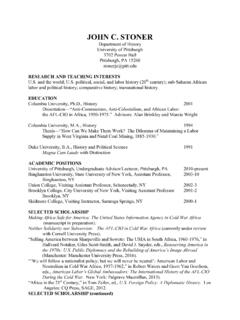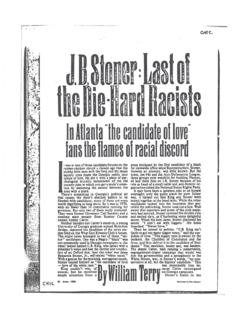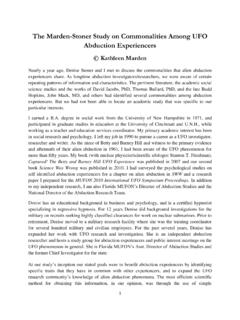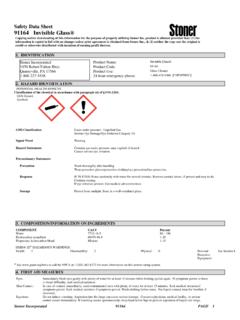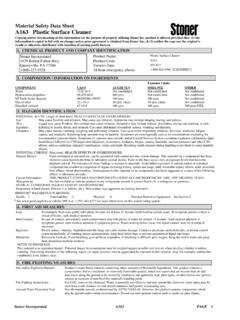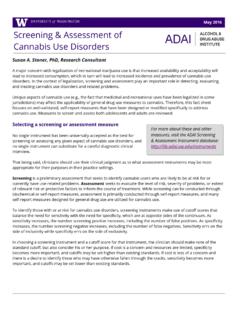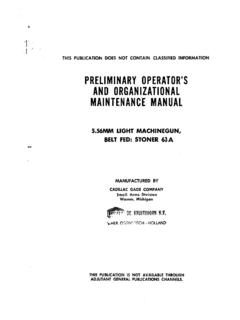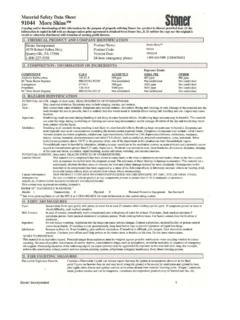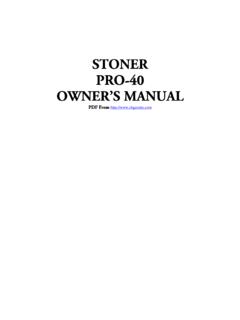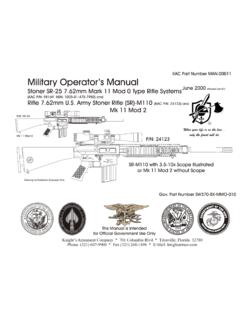Transcription of Material Safety Data Sheet - Shop
1 Stoner Incorporated 91034 PAGE 1 Safety data Sheet91034 Trim Shine Copying and/or downloading of this information for the purpose of properly utilizing Stoner Inc. product is allowed provided that: (1) the information is copied in full with no changes unless prior agreement is obtained from Stoner Inc., & (2) neither the copy nor the original is resold or otherwise distributed with intention of earning profit IDENTIFICATIONS toner IncorporatedProduct Name:Trim Shine 1070 Robert Fulton Code:91034 Quarryville, PA 17566 Product Use:Automotive Appearance1-800-227-553824-hour emergency phone:1-800-424-9300 [CHEMTREC]2.
2 HAZARD IDENTIFICATION POTENTIAL HEALTH EFFECTSC lassification of the chemical in accordance with paragraph (d) of ;GHS Hazard SymbolsGHS ClassificationFlammable Aerosol Category 1 Gases under pressure - Liquified GasAspiration Hazard Category 1 Skin Corrosion/Irritation Category 2 Specific Target Organ Systemic Toxicity (STOT) - Single Exposure Category 3 Signal WordDangerHazard StatementsExtremely flammable gas under pressure; may explode if be fatal if swallowed and enters skin cause drowsiness or Statements PreventionKeep away from heat/sparks/open flames/hot surfaces.
3 No not spray on an open flame or other ignition container: Do not pierce or burn, even after breathing dust/fume/gas/mist/ thoroughly after only outdoors or in a well-ventilated protective gloves/protective clothing/eye protection/face protection. ResponseIF SWALLOWED: Immediately call a POISON CENTER/doctor/..IF ON SKIN: Wash with plenty of soap and INHALED: Remove victim to fresh air and keep at rest in a position comfortable for a POISON CENTER or doctor/physician if you feel treatment (see .. on this label).Do NOT induce skin irritation occurs: Get medical off contaminated clothing and wash before reuse.
4 StorageStore in a well-ventilated place. Keep container tightly locked from sunlight. Store in a well-ventilated from sunlight. Do no expose to temperatures exceeding 50 C/ 122 F. DisposalDispose of contents/container in accordance with local/regional/national/international regulation for hazardous Incorporated 91034 PAGE 23. COMPOSITION/INFORMATION ON INGREDIENTSCOMPONENTCAS #PercentAliphatic hydrocarbon142-82-540 - 60 Hydrocarbon propellant68476-86-820 - 40 HMIS III* HAZARDOUS WARNINGS:Health:1 Flammability:4 Physical:0 Personal Protective Equipment:See Section 8* See or call the NPCA at 1 (202) 462-6272 for more information on this current rating FIRST AID MEASURESEyes:Immediately flush eyes gently with plenty of water for at least 15 minutes while holding eyelids apart.
5 If symptoms persist or thereis visual difficulty, seek medical Contact:In case of contact, immediately wash contaminated area with plenty of water for at least 15 minutes. Seek medical attention if symptoms persist. Seek medical attention if symptoms persist. Wash clothing before reuse. For liquid contact, treat for frostbite if :Do not induce vomiting. Aspiration into the lungs can cause serious damage. Contact a physician, medical facility, or poison control center immediately. If vomiting occurs spontaneously, keep head below hips to prevent aspiration of liquid into :Remove to fresh air.
6 If not breathing, give artificial respiration. If breathing is difficult, give oxygen. Seek immediate medical TO PHYSICIAN:This Material is an aspiration hazard. Potential danger from aspiration must be weighed against possible oral toxicity when deciding whether to induce vomiting. Because of possible disturbances of cardiac rhythm, catecholamine drugs, such as epinephrine, should be used only in situations of emergency life support. Preexisting disorders of the following organs (or organ systems) may be aggravated by exposure to this Material : skin; lung (for example, asthma-like conditions); kidney; central nervous system; auditory system; arrhythmias (irregular heartbeats);5.
7 FIRE FIGHTING MEASURESFire and/or Explosion Hazards:This product contains a component(s) that is considered a flammable liquid, which has vapors that are heavier than air and may travel along the ground or be moved by ventilation and ignited by heat, pilot lights, or other flames and ignition sources at locations distant from the Material 's handling point. This product contains a component(s) that is considered an extremely flammable gas(es), which has vapors that are heavier than air and may travel along the ground or be moved by ventilation and ignited by heat, pilot lights, or other flames and ignition sources at locations distant from the Material 's handling point.
8 "Empty" containers retain product residue and can be Fighting Instructions:Use CO2, foam or dry chemical. Fire fighters should wear normal protective equipment and positive-pressure self-contained breathing ACCIDENTAL RELEASE MEASURESSTEPS TO BE TAKEN IF Material IS RELEASED OR SPILLED:Ventilate contaminated area. Remove all sources of ignition. Wear appropriate personal protective equipment (PPE). Stop or reduce discharge if it can be done safely. Avoid run-off into storm sewers and ditches which may lead to natural waterways. If runoff occurs, notify authorities as required.
9 Clean up with absorbent Material . Place absorbent materials into container and close it tightly. Dispose of container HANDLING AND STORAGEH andling:Do not use near ignition sources. Normal precautions common to safe manufacturing practice should be followed in handling and storage. This Material can be harmful or irritating. Avoid prolonged or repeated contact with skin. Avoid prolonged or repeated breathing of vapor. Use with adequate ventilation. Do not pressurize, cut, weld, braze, solder, drill, grind, or expose such containers to heat, flame, sparks, static electricity, or other sources of ignition; they may explode and cause injury or : Store in a cool, dry, well ventilated area away from all sources of ignition.
10 Empty container may contain residues which are hazardous. Normal precautions common to safe manufacturing practice should be followed in handling and storage. Do not store at temperatures above 120 degrees F. Store away from incompatible materials such as materials that support combustion (oxidizing materials) and corrosive materials (strong acids or bases).Stoner Incorporated 91034 PAGE 38. EXPOSURE CONTROLS / PERSONAL PROTECTIONE ngineering Controls:Ventilation should be adequate to prevent exposures above the limits indicated below in this section of the MSDS (from known, suspected or apparent adverse effects).
